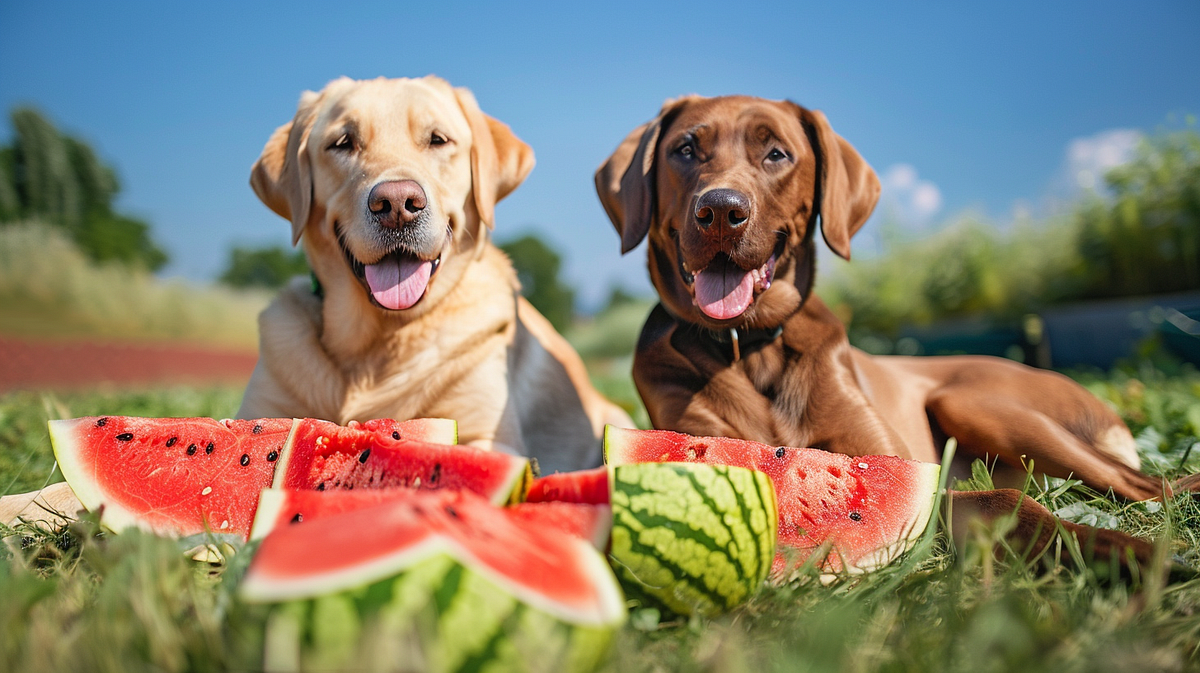
Can Dogs Eat Watermelon? The answer is yes! Watermelon is safe for dogs when given in moderation. This refreshing fruit can be a fun treat, especially on warm days.
Just remember to remove the seeds and rind to prevent choking and digestive issues. Offer watermelon as an occasional snack rather than a regular part of their diet, and your pup will love it! So, let’s explore together that- can dogs eat watermelon?
Nutritional Benefits of Watermelon for Dogs
When considering what snacks to offer your furry friend, you might wonder, can dogs eat watermelon? The answer is a resounding yes! Watermelon can be a refreshing and nutritious treat for dogs, especially during hot summer days. Here’s a closer look at the nutritional benefits that watermelon can provide for your canine companion.
1. High Water Content
Hydration:
- Watermelon is composed of about 92% water, making it an excellent source of hydration for dogs. This is particularly beneficial during hot weather when your dog may need extra fluids.
2. Vitamins and Minerals
Vitamins A, B6, and C:
Watermelon is rich in essential vitamins that support various aspects of your dog’s health:
- Vitamin A: Promotes healthy skin and good vision.
- Vitamin B6: Important for protein metabolism and cognitive function.
- Vitamin C: Acts as an antioxidant and helps boost the immune system.
3. Antioxidants and Amino Acids
Overall Well-Being:
- Watermelon contains antioxidants that help combat free radicals in the body, reducing inflammation and supporting overall health.
- It also includes amino acids like citrulline, which can help improve blood flow and reduce muscle soreness after exercise.
Watermelon is not only a delicious treat but also offers numerous nutritional benefits for dogs. With its high water content and rich array of vitamins, antioxidants, and amino acids, watermelon can be a great addition to your dog’s diet, especially during warmer months. Always remember to serve it safely—remove the seeds and rind—and enjoy watching your dog relish this tasty and healthy snack!
Risks of Feeding Watermelon to Your Dog
When considering whether can dogs eat watermelon, it’s essential to be aware of potential risks. While watermelon can be a nutritious and hydrating treat for dogs, there are some precautions to take. Here’s a closer look at the risks associated with feeding watermelon to your furry friend.
1. Intestinal Blockages from Seeds
Seed Hazards:
- Watermelon seeds can pose a choking hazard and may cause intestinal blockages, especially in small dog breeds. Even though watermelon seeds are not toxic, they can lead to serious digestive issues if ingested in large quantities.
2. Digestive Difficulties from the Rind
Rind Risks:
- The tough rind of watermelon is challenging for dogs to digest. Feeding the rind can lead to stomach upset, gastrointestinal discomfort, and potential choking hazards. It’s crucial to only offer the fleshy part of the watermelon to your dog.
3. Diarrhea from Overfeeding
Fiber and Water Content:
- While watermelon is low in calories, it has a high water and fiber content. Overfeeding watermelon can result in digestive upset, leading to diarrhea or loose stools. Moderation is key to preventing these issues.
While watermelon can be a refreshing and healthy treat for dogs, it’s important to be cautious. Always remove seeds and the rind, and serve watermelon in moderation to avoid digestive problems. By taking these precautions, you can safely share this summer fruit with your furry companion!
How to Serve Watermelon Safely to Your Dog
If you’re wondering can dogs eat watermelon, the answer is yes, but it’s crucial to serve it safely. Watermelon can be a delicious and hydrating treat for your furry friend, especially during hot weather. Here are some tips on how to prepare and serve watermelon to ensure your dog enjoys it without any risks.
1. Cut into Bite-Sized, Seedless Pieces
Preparation:
- Start by selecting a fresh watermelon.
- Remove all seeds to prevent choking and intestinal blockages.
- Cut the watermelon flesh into small, bite-sized chunks to make it easy for your dog to eat.
2. Avoid the Rind
Rind Warning:
- Always discard the tough rind.
- The rind is hard to digest and can lead to gastrointestinal upset or choking.
- Only offer the soft, red flesh of the watermelon to your dog.
3. Monitor Your Dog While Eating
Supervision:
- Keep an eye on your dog as they enjoy their treat.
- Supervision can help prevent choking and ensure they are eating safely.
4. Freeze for a Refreshing Snack
Frozen Treats:
- For a fun and cooling summer treat, consider freezing small chunks of watermelon.
- This can make for a great, hydrating snack on hot days, and many dogs enjoy the cold texture.
By following these simple steps, you can safely share watermelon with your dog. This refreshing fruit can be a delightful addition to their diet, providing hydration and essential nutrients. Just remember to prepare it correctly and serve it in moderation!
Signs Your Dog May Be Allergic to Watermelon
While watermelon can be a refreshing and healthy treat for your dog, it’s important to monitor them for any signs of an allergic reaction. Can dogs eat watermelon safely? Generally, yes, but some dogs may still react negatively. Here are the key symptoms to watch for:
1. Gastrointestinal Issues
- Vomiting: If your dog vomits after eating watermelon, it could indicate an intolerance or allergy.
- Diarrhea: Loose stools or diarrhea are common signs of digestive distress after consuming watermelon.
2. Skin Reactions
- Excessive Scratching: If your dog starts scratching more than usual, it could be a sign of an allergic reaction.
- Rashes or Hives: Look for any unusual skin reactions such as rashes or hives.
3. Swelling
- Facial Swelling: Swelling around the face, particularly around the mouth or eyes, is a concerning sign.
- Mouth Swelling: If you notice your dog’s mouth or tongue swelling, it may indicate a severe allergic reaction.
4. Breathing Difficulties
- Labored Breathing: Difficulty breathing or wheezing can be serious and requires immediate attention.
- Coughing: Frequent coughing or a change in breathing patterns can also be signs of an allergic reaction.
If you observe any of these symptoms after feeding your dog watermelon, it’s important to discontinue the treat and consult your veterinarian. Prompt action can help ensure your dog’s health and well-being, allowing them to enjoy safe snacks without any adverse reactions.
Healthy Alternatives to Watermelon for Dogs
If you’re looking for healthy treats for your furry friend, there are plenty of options besides watermelon. While can dogs eat watermelon safely, you might want to explore other fruits and snacks to keep their diet varied and exciting. Here are some great alternatives:
1. Safe Fruits for Dogs
- Apples: Apples are a nutritious option packed with vitamins A and C. Just be sure to remove the seeds and core before sharing!
- Bananas: Bananas are low in calories and rich in potassium. They make a sweet treat that many dogs love.
- Blueberries: These tiny berries are antioxidant powerhouses and provide vitamins while being low in calories. They’re perfect for a quick snack.
2. Fruits to Avoid
- Grapes and Raisins: These can be toxic to dogs and may cause kidney failure.
- Cherries: Cherry pits contain cyanide, which is harmful to dogs. Always avoid feeding cherries.
3. Vegetable Options
- Carrots: Crunchy and low in calories, carrots are a great source of fiber and vitamins. They can be given raw or cooked.
- Green Beans: Fresh or steamed green beans are a healthy, low-calorie snack that many dogs enjoy.
- Cucumbers: Low in calories and refreshing, cucumbers are great for hydration.
4. Dog-Specific Snacks
- Commercial Dog Treats: Consider treats specifically formulated for canine nutrition. Look for low-calorie options that include natural ingredients.
- Homemade Dog Treats: You can also make your own dog treats using ingredients like pumpkin, oats, and peanut butter (make sure it’s xylitol-free).
Conclusion
Incorporating a variety of safe fruits and vegetables can enhance your dog’s diet and provide essential nutrients. Always introduce new foods gradually and observe your dog for any adverse reactions. By diversifying their treats, you can keep mealtime fun and nutritious while ensuring their health and happiness.



